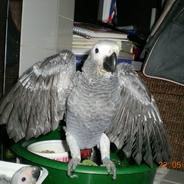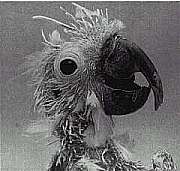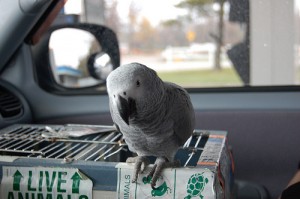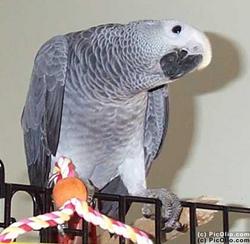
The African grey Parrot has a history with humans dating back to biblical times, a fact that is no wonder to today’s grey owners after all, these lucky people live with one of the most talented and beautiful birds alive, an animal able to charm royalty and researchers for centuries.
The first aspect of this animal that you notice is that it’s gorgeous the African grey’s feathers appear like a hand-scalloped costume of armor, like hundreds of perfect little seashells laid across one another to form a velvety gown for this intelligent and talkative bird and let’s not forget those ever-watchful eyes and that beautiful crimson tail! But it’s this bird’s personality and intelligence, beyond it’s good looks, that keeps owners hooked.
Although this bird is a favorite among expert bird keepers and novices alike perhaps the second most favored bird next to the popular cockatoo this is not a bird that comes with a thin instruction manual. On the contrary, you will need a whole suitcase of information to keep your pretty grey pet happy and healthy. Read on …
1. African Greys come in two recognized sub-species.
African Grey Parrots are recognized in two distinct subspecies: the Congo African grey (Psittacus erithacus erithacus) and the Timneh African grey (Psittacus erithacus timneh). Both of these subspecies are found in … you guessed it … Africa, with the Congo found in the Southeastern Ivory Coast, Kenya, and Tanzania, and the Timneh found in a smaller region along the western edge of the Ivory Coast and through southern Guinea. Large Congos are sometimes called Cameroons, a misnomer stemming from smugglers bringing the birds into Cameroon and having that country written on the birds’ export papers. Because the African grey’s native range is so expansive, these birds tend to come in a variety of sizes and shades of coloring, which can lead an owner to believe that they have a different subspecies.
The Congo is by far the favorite of the two subspeciesit is larger and its feathers are more prominently scalloped, and it has a bright scarlet tail that reaches full coloring at maturity. The Timneh is smaller with a darker grey body, and its tail ranges in color from maroon to dark grey. The Congo tends to be more aloof while the Timneh can be more of a family bird. Both birds make equally good pets, and one should not be considered superior over the other.
The African grey parrot is one of the many species of animals on a list as part of the Convention of International Trade in Endangered Species (CITES) treaty, and as such is banned from commercial international trade. Your African Grey, if it is less than around 10 years old, was probably domestically bred, which is far better for the environment and for your bird and its parents. The CITES treaty was drawn to protect wildlife from over exploitation and from risk of the threat of extinction. If for some reason you suspect that a bird you are going to purchase is smuggled, do not go through with the purchase. Instead, buy from a reputable breeder or bird shop.
2. African Greys are highly sensitive creatures.
The sensitivity of the African grey is unrivaled among companion birds, with the possible exception of the cockatoo. This sensitivity is part of the grey’s charm, but can also lead to common behavioral problems. Even a small change in daily routine or in the bird’s surroundings can lead to plucking and crankiness.
Zane, our wild-caught Congo grey began to pluck his feathers several years ago, said Bob and Liz Johnson, founders of the Shyne Foundation, a free flight parrot sanctuary in Florida. Zane is used to flying free in our enclosed ¼ acre habitat and to sleeping in a cage in the house at night. We realized we had been letting him out a little later than usual in the morning for a few weeks and when we began letting him out at the crack of dawn the plucking stopped.
Realize that your new grey is an individual with a highly sensitive nature and has to get used to its new surroundings. The most frequent misconception I encounter with new owners is that they expect the Grey to love and trust them too quickly, Bobbi Brinker, author of For the Love of Greys and the site owner of www.ParrotTalk.com and The Grey Connection. Building a relationship takes time and effort. It is unreasonable to expect a grey to give his heart immediately to a stranger no matter how anxiously awaited for or loved he is by the new owner.
3. African Greys are great talkers.
The myth of the loquacious grey is more than just a myth it’s a reality. The grey is one of the top talkers among psitticines, and grey fanciers will tell you that they are the best, able to repeat words and phrases that they have heard just a few times, perhaps even only once. Greys come into their full talking ability as they approach one year of age, but may pick up a few words sooner than that.

Not only will these birds develop outstanding vocabularies, they may even come to understand what they are saying. Merlin, my grey, and I were accompanying Dr. Pepperberg at a conference in California a few years ago, said Maggie Wright, creator and publisher of the Grey Play Round Table Magazine. Merlin was having such a good time on the trip that on the final day she said, thisa sucha fun yuk, yuk, while bouncing on her perch. The words were parts of phrases that she had picked up at different times.
Though these birds are known to talk up a storm, not all African greys learn to talk. Some will learn a variety of other household sounds, as well as specific whistles. Talking is, to me, the least of a grey’s vocal talents, said Neil Sims, bird enthusiast and owner of Stella, a six-year-old Congo. Stella meows like a cat, calls exactly like the blue jay who eats from the bird feeder outside, imitates my asthmatic cough and my laugh, water going down the drain, and she improvises whistles to accompany whatever music I’m playing on key.
4. African Greys are extremely intelligent.
Intelligence is probably one of the main factors making the African grey one of the most desirable companion birds available today. The most famous grey of all, Alex, and his owner, Dr. Irene Pepperberg, may just be the reason for the popularity surrounding the grey. Alex, now 23 years old, is the continuing subject of a research study conducted by Dr. Pepperberg and her students at the University of Arizona. Using specialized techniques that involve repetition and reward, the researchers have taught Alex to recognize and identify verbally close to 50 objects, 7 colors, and 5 shapes. Alex can understand the concepts of category, same and different, and can even count. Someday researchers believe that Alex may even be able to learn to read. This is far more than just mimicry. Alex is actually able to think in abstract concepts and quantify objects with over an 80% accuracy rate. Imagine living with a creature that is able to understand what you are saying to the degree that a three or four year old child would understand. That’s a lot of animal!
Because this species is so intelligent, boredom and inactivity can lead to frustration. The most important thing for a potential owner to know about African greys is that they are much more intelligent than they are often given credit for, said Dr. Karen Zielezienski-Roberts, the avian veterinarian at Academy Animal Hospital in Ft. Lauderdale. Florida. Greys that are neglected socially, will tend to develop behavioral problems, and the resultant stress can predispose them to myriad medical issues.
Beyond medical issues stemming from boredom and stress due to this bird’s intelligent nature, there’s the issue of living with another species that may often outwit you. Greys will tend to train you to do their bidding, said Sims. Therefore not only is an infinite capacity for love required for owning a grey, but an unyielding ability to set up consistent boundaries, training, and positive reinforcement.
Because researchers have had such great success with Alex, Dr. Pepperberg, now doing research at MIT in Boston, is training another grey, Arthur, to use the Internet. Eventually, Pepperberg hopes, parrots will have access to the World Wide Web and will surf to alleviate their boredom, and perhaps will even be able to video conference with their friends. Be nice to your grey he may someday have access to your computer!
5. African Greys are quiet birds though quiet is a relative term!
Greys make good apartment birds. They do make noise, but they are not insistent, the way an Amazon or a conure can be. Greys don’t scream they whistle, click, and beep. Most of the noise they make is rather pleasant to the ear, said Jean Pattison, known as The African Queen, a breeder of greys since 1984. A scared grey will growl. They can, when they are playing hard, emit something similar to a bark, but they don’t sit in the cage and beg or cry and drive you crazy like other birds will.
As with any bird, be prepared for some noise no bird you purchase is going to be absolutely quiet. Despite my efforts, Stella, my six year old Congo, will try to wear me out by repeating her broken-smoke-alarm imitation until I return to the particular room she is in. I try to hold out, and wait until she calls in words or some other sound less grating, said Sims.
5. African Greys love to eat and chew.
If started early on a good diet, most greys are not fussy eaters. Both of my greys are very good eaters, said Wright. Their favorite foods are a seven grain hot cereal served with a banana slice and rice milk, eggs, prepared any style, small pieces of grilled salmon, apple, and a daily mash of vegetables and grains.
Stella eats like a little grey vulture, said Sims. Chicken bones, pasta, thawed mixed vegetables, pellets, seeds, almonds, fruit, shrimp, and salmon . . . she eats better than I do.
As with any bird, greys have the tendency to chew things that are available to them electric cords, antique furniture, curtain rods. Be aware, if you turn your back on a grey that is out of its cage, you may be surprised at the condition of your 18th century coffee table when your return. Greys are not overly distructive, said Pattison, but if you have an antique table and the bird is out, it will get to your table. I have a bird that has never chewed a thing, and another who chewed my window frames. On a destruction scale of one to ten, the grey is probably a 3 or a 4. But believe me that your grey will get to your antiques. The minute you have something precious where your bird can reach it, it’s history.
6. The African Grey is not often the best choice for an owner’s first bird.
Buying a bird with this amount of intelligence and sensitivity takes a lot of thought and possibly some knowledge of how to care properly for birds in general. You may want to wait until you’ve got some experience under your birdy belt before you undertake the responsibility of this sensitive bird with a lifespan of possibly over 50 years. I do not recommend the African Grey parrot as a first bird, said Sims. They are incredibly intelligent and socially needy birds. This is the perfect combination to create for boredom in the insufficiently stimulated bird. Boredom in greys almost invariably leads to screaming and feather picking. Moreover, their first reaction to anything unexpected, even a paper flittering across a floor, or a new bird toy is one of fear and mistrust. Unlike most Amazons who confront such situations with confidence, anger, or playfullness, the grey needs lots of concentrated assurance, consistent security, and inexhaustible affection. A grey is not a bird for people who tire of novelty easily or are incapable of giving the same physical and emotional attention to a pet that they would give to a small child.
Most inexperienced bird owners may find themselves between a rock and a hard place with this advice. Someone may really want a grey but find themselves advised out of the purchase by a breeder or pet shop owner, who may suggest to them instead to a smaller, more easily cared for bird. If you want an African grey no other bird will satisfy you, said Pattison. You will go back and end up buying a grey.
If you really want a grey, my advice is to get one, but buy it from someone who is willing to work with you, to help you to learn to care for the bird properly. Do your homework first. Don’t buy a grey or any bird on impulse. Talk to other people that own greys, do some thinking before you finally make your decision.
7. African Greys are exceptionally flock oriented.
When you own a dog, you are part of the pack. With birds, you are part of the flock, and must act as such with the grey, a species whose powerful flock-oriented instinct will drive your bird to want to be with you 24 hours a day.
Greys are what ornithologists refer to as ‘single species flock’ birds, which means there are only African greys in a flock, said Jane Hallander, Avian Behavior Consultant and Telepathic Animal Communicator. Many South American parrot species belong to ‘multi-species’ flocks, consisting of macaws, amazons and conures. Because no other species are allowed in African grey flocks. They do not take well to other parrot species in a household, often trying to drive the ‘intruder’ away. Greys, as with many other parrot species, spend approximately 24 hours a day with their mate. When they have no grey to bond to, they bond to a human and instinctively expect to spend all of their time with that person. When that doesn’t happen, the bird calls for them. If the person doesn’t respond, but the grey knows the person is in close by, the bird calls louder and louder until it becomes what we call ‘screaming’. This is easily solved by arranging for the grey to be in the same room as its person, via play stands, climbing trees, etc. Now, we are satisfying the grey’s natural instinctive behavior, solving the screaming problem and all are happy. Jane Hallander
Maggie Wright concurs with using the grey’s flocking instinct to better understand your bird. Helping your grey feel secure and a part of the family flock is the most important thing you can do, said Wright. This means placing it in the family room, instead of a bird room, and including it in your daily rituals and activities. Teach your grey to handle new experiences, but do it slowly, at the bird’s pace.
8. African Greys are not cuddlers.
Often people will buy bird and expect to be able to hug and caress their new feathered friend. Greys will tolerate a little head scratching and perhaps a caress or two, but they do not appreciate intense physical contact. People often refer to greys as being ‘nippy’. They are not nippy, said Hallander. They are also not grey cockatoos and do not like as much physical handling as do some cockatoo species. I constantly hear clients tell me they want to ‘pet’ their greys more, but the grey bites them. We teach our greys to bite when we do not recognize their body language telling us that they do not want to be petted or scratched at that moment. When that happens the bird goes to plan ‘B’, a bite. The person goes away and the bird gets what he wants, to be left alone. The next time the grey doesn’t waste time pushing the person’s hand away. He already knows what works a bite.

9. African Greys can be one person birds.
Some bird species will react with the same gusto and friendliness to every member of the family not so with greys. The Timneh may be more capable of accepting more family members than the Congo, but, as with all birds, behavior is highly individual. Nevertheless, greys can be socialized to accept every member of the family your bird’s behavior depends largely on how you treat it.
Greys can be one person birds, and for the most part they are, said Pattison. Don’t expect to bring home a little person in feathers a grey is a bird. People call me and say ‘please train my bird not to bite and not to chew before I pick it up. They get the misconception that this is a little cuddly puppy in feathers and it’s not. If you’re going to get a grey and you don’t want it to be a one-person bird, take the time to socialize it. The best behaved greys I have ever seen I have sold to young adults they drag the bird everywhere with them and the bird becomes more adjusted these people don’t over protect the bird and the bird becomes accepting of change, noises, and people.
10. African Greys may need more calcium than other bird species.
The hypothesis that greys need more calcium than other birds is still up for debate, but nevertheless, many pet owners find themselves in the veterinarian’s office with a diagnosis of low calcium in the blood, which can lead to seizures and other medical complications.
The most common medical problems associated with African Greys include hypocalcemia, feather picking, respiratory disease, and malnutrition, said Dr. Zielezienski-Roberts.
Greys seem to need more calcium than some other species, said the Johnsons. But calcium alone is not enough. It takes a number of other nutrients to properly absorb the calcium, such as magnesium, lysine, boron, vitamins C,D, and K, which are all part of the calcium complex. We have seen greys who were having seizures and the veterinarian was giving them calcium shots, with no results until the other parts of the complex, especially magnesium, were given.
Don’t think of giving calcium, or any other dietary supplements, until you speak with your avian veterinarian about your bird’s diet and health. Greys don’t metabolize calcium as easily as other birds, and can become deficient more easily, said Pattison. Greys are known to have calcium problem, but don’t supplement unless it’s under the advice of a veterinarian. I feed 70% pellets and 30% seed and I’ve never seen a problem in my birds.
11. African Greys can be the perfect pet or the worst depending on how the bird is raised.
Though African greys come with certain inherent behaviors and requirements, how you raise your bird is the most important factor determining how you and your bird get along.
Make sure that the person or the place that you purchase the bird from is willing to work with you to make you and the bird as happy as possible. I tell my customers that, if the bird is not raised correctly, it will manifest many behavioral problems later on in life and the customer will wish they never got the bird, said Marc Morrone, owner of Parrots of the World, host of Cablevision’s The Pet Shop and resident on-air pet expert on Martha Stewart’s Living Television. To prevent this it is important that the store and the customer work together to raise the bird.
Because the grey is so very sensitive, you must take a look at your own lifestyle and ask yourself whether this bird will be a good addition to your family, or whether you will both be unhappy living together. The potential is there for both possibilities. Really think about purchasing a grey and try to be as honest with yourself as possible, said Sims. If you’ve already had experience with other parrots, you are willing to make a lifelong commitment to a 4 year old child that’s about the grey’s intelligence and emotional level a child who will never grow up, but who will always remain as difficult, but also as endearing, then maybe the gorgeous grey is the bird for you.
About the Author
Original Source: http://members.authorsguild.net/goodbird/work13.htm








